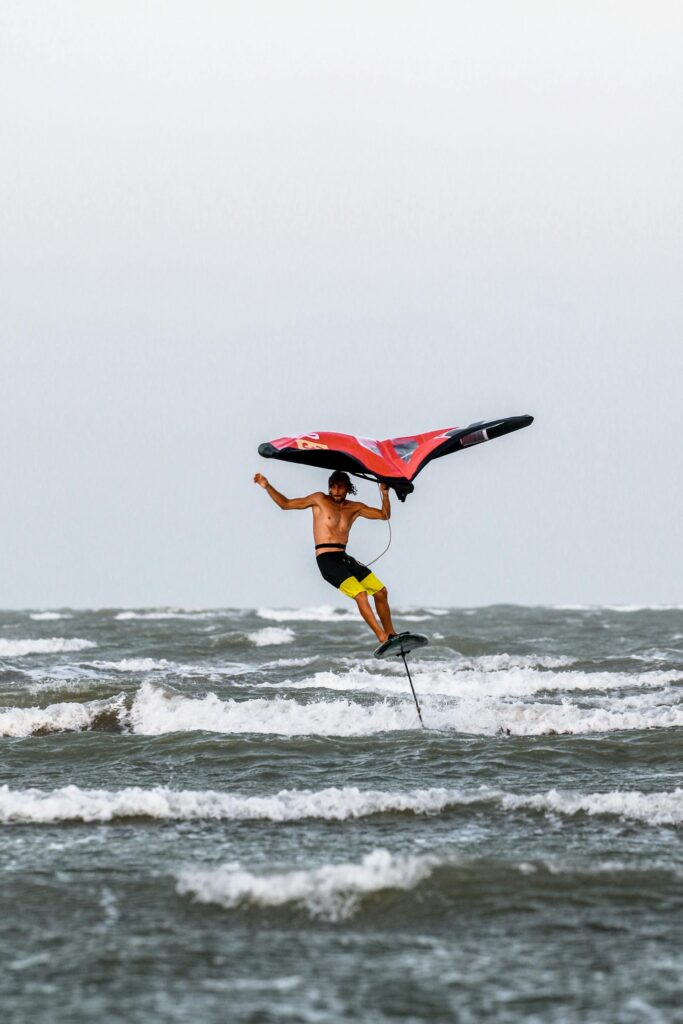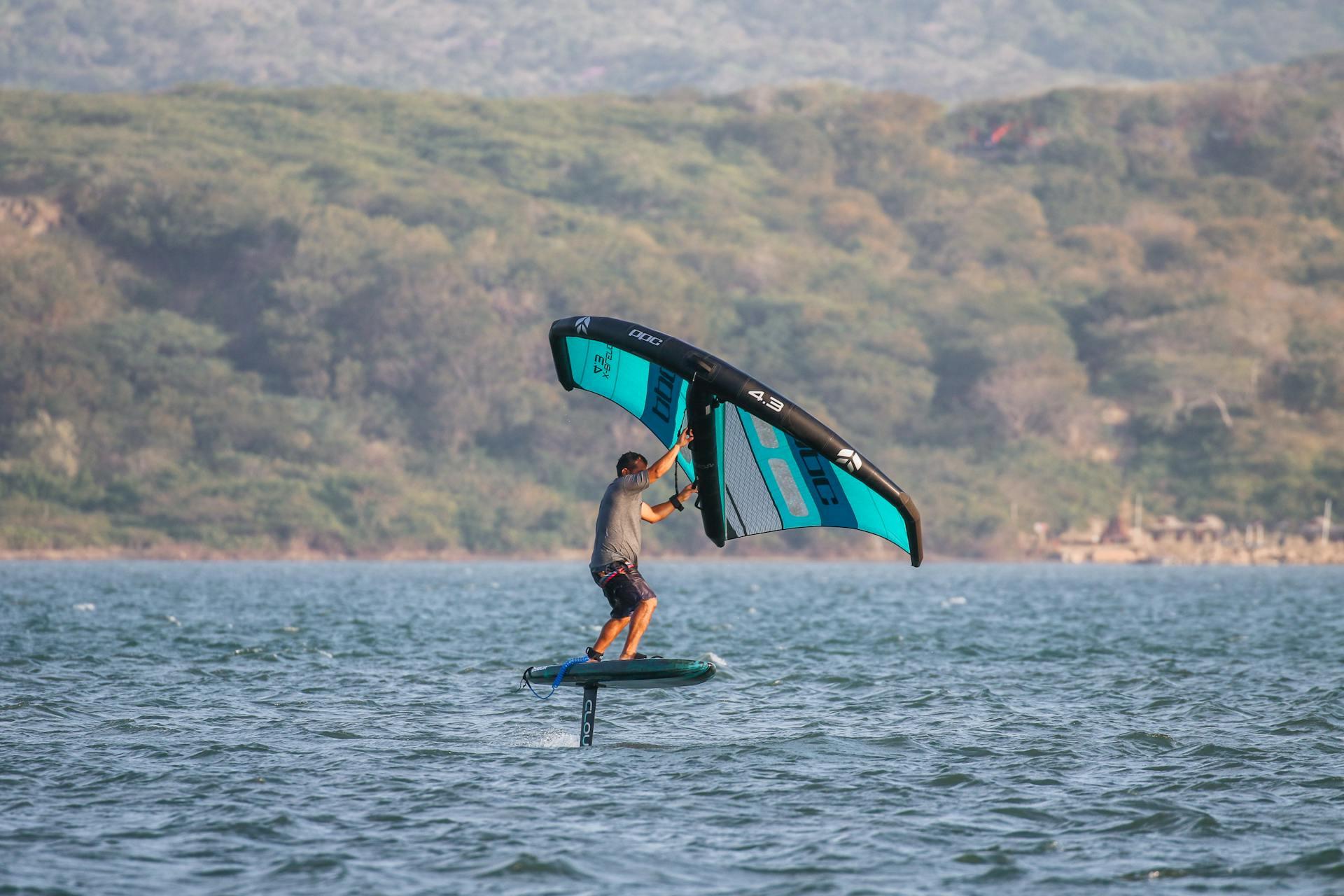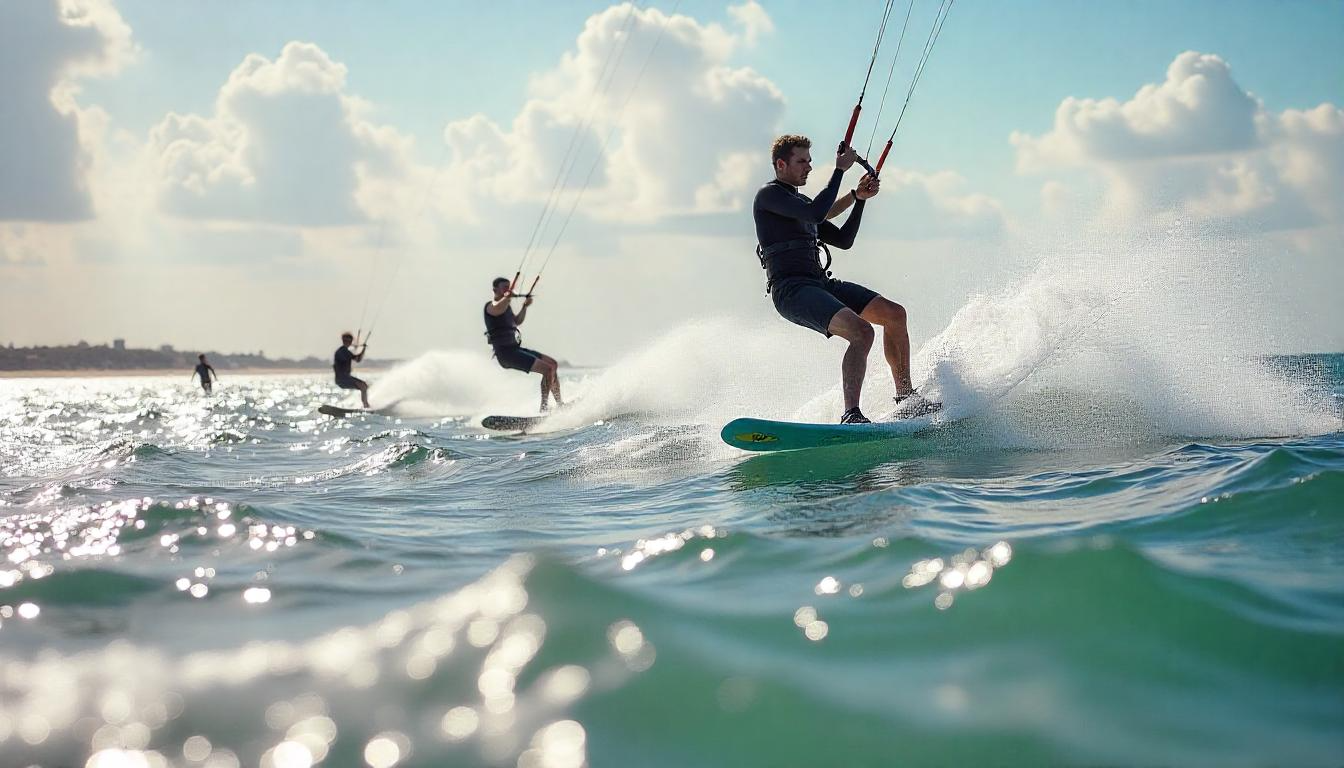Tacking is an important skill in wing foiling that helps you sail against the wind. This move requires carefully turning both the board and the wing as you navigate through the wind. It’s crucial to keep control and speed during this maneuver. Mastering wing foiling tacking allows you to access new spots and enjoy more time on the water. To improve your wing foiling tacking, start by working on coordination. Your body movements should align with the wing’s position. Shift your weight smoothly from one side of the board to the other to stay balanced while adjusting the wing.
Next, focus on your hands when gripping the wing handle. As you turn, make sure your hands move quickly but steadily. A swift motion helps the wing catch the wind effectively. Timing is also key. Begin your turn just before reaching the wind’s eye. This early action gives you enough time to finish the turn without losing speed. Use your eyes to guide you. Look in the direction you want to go, as this helps your body and the board turn smoothly.
Regular practice is vital. The more you practice, the more these movements will feel automatic, especially when using wing foiling tacking techniques. Finally, pay attention to wind speed and water conditions. Start in lighter winds to gain confidence, and as you improve, try stronger winds and tougher waters. By following these steps, you can sharpen your wing foiling tacking skills, making it easier to head upwind and enjoy wing foiling even more.

Understanding the Basics of Wing Foiling Tacking
Wind Direction: Knowing where the wind is coming from is essential for any wing foiling tacking tutorial. The wind’s direction in relation to your board plays a key role in how you tack. If the wind is hitting your board from the left side, you are sailing on what is known as port tack. In this case, your bow, or front of the board, is pointing towards the wind. Conversely, when the wind comes from your right side, you are on starboard tack. This means that your bow is once again pointed towards the wind, but from a different angle. Recognizing these points is vital for effective wing foiling tacking.
The Turn: Tacking involves making a significant change in direction. Specifically, you perform a 180-degree turn to shift from one tack to another. During this wing foiling tacking maneuver, the bow of your board swings through the wind. It is crucial to time this turn well, as poor timing can cause a loss of control or speed. Executing a successful tack requires practice and an understanding of how your board reacts to the changing wind conditions.
The Goal: The main aim of wing foiling tacking is to maximize your speed while making progress against the wind. By effectively using the wind, you can sail upwind with greater efficiency. Keeping your speed high during the maneuver helps maintain momentum. The challenge lies in balancing the need to change direction with the desire to keep moving quickly. A well-executed tack not only allows you to change direction but also helps you sail closer to your destination.

Pre-Tack Preparation for Wing Foiling Tacking
Speed and Angle: Preparing for a tack is crucial for a successful ride on your board. First, you need to control your speed and angle as you approach the tack. Keeping a steady speed is key since it gives you the momentum needed for a smooth turn. As you get closer, tilt your board slightly into the wind. This angle helps you catch the wind while managing your balance on the board.
Wing Position: Next, consider the position of your wing. It should be slightly in front of your body as you move. Avoid placing it directly above or behind you; instead, angle it forward. This proper placement helps maintain stability and balance, making it easier to steer during the turn in your wing foiling tacking practice.
Body Posture: Your stance also matters a lot. Keep your weight spread evenly across the board. Centering your weight improves control and response, which is especially important for wing foiling tacking for beginners. Engage your core to enhance stability. Leaning back may seem natural during the turn, but it’s best to avoid it. Leaning back can throw off your balance and make the tack harder to complete. By following these tips, you can achieve a smoother tack, improving your overall performance on the board.

Executing the Wing Foiling Tacking
Initiate the Turn: Start by initiating the turn. This means shifting your weight to the opposite foot. This simple action prepares your body for the upcoming change in direction. It is crucial because it lays the groundwork for everything that follows, making it easier to guide your equipment smoothly during the wing foiling tacking exercises.
Rotate the Wing: Next, focus on rotating the wing. Its like adjusting the wing to catch the wind at the right angle. You can switch hands or use a mix of hand and body movements to achieve this. Keeping the wing aligned with the wind during your turn boosts your lift and control. Good rotation is essential for maintaining speed and balance while wing foiling tacking.
Maintain Momentum: As you make the turn, it’s vital to maintain momentum. Use your legs to pump the wing or pick up speed. This movement helps your balance and keeps you moving forward. Keeping some speed will help you finish the turn smoothly and maintain your control.
Adjust Your Stance: As the turn nears its end, adjust your stance. Pay attention to how your weight is spread during this time. Make sure you feel balanced on your feet, which helps you stay in control. A stable stance keeps you from stumbling after the turn. By distributing your weight evenly, you enhance your stability and set yourself up for the next part of your sailing adventure. Each of these steps is crucial for mastering the tack, which ultimately improves your skills and enjoyment on the water.

Common Mistakes and How to Avoid Them in Wing Foiling Tacking
Losing Speed: Losing speed is a major issue many face when making a tack, especially in wing foiling tacking drills. When speed drops, it can throw off the entire maneuver, leading to a frustrating experience. To keep this from happening, focus on maintaining a steady pumping motion throughout. This means using your legs to push down powerfully and rhythmically, which helps maintain speed and leads to a smoother tack. By developing a consistent pumping rhythm, you will keep your speed steady and navigate turns more efficiently and confidently.
Stalling the Wing: Another common mistake in wing foiling tacking is stalling the wing. A stalled wing loses lift, causing a quick drop that can surprise you. To prevent this, always check the wing’s position while maneuvering. Proper alignment is crucial for control. Make sure you generate enough power as you move. This keeps the wing in the right position and up in the air. Regular practice will improve your ability to keep the wing flying smoothly, helping you execute tacks more accurately and reducing the chance of stalling.
Losing Balance: Losing balance is another frequent issue that can lead to falls and disrupt your performance during wing foiling tacking. Once you lose balance, it can be hard to regain it. To avoid this, keep your weight centered over the board. Engage your core muscles to improve control and stabilize your body. By focusing on balance and weight distribution, you can enhance your stability on the water. This not only makes your time more enjoyable but also makes outings safer, allowing you to tackle the waves with confidence. Remember, practice helps you improve, and being aware of these wing foiling tacking mistakes will make you a better water sports enthusiast.

Practice and Progression in Wing Foiling Tacking
Start Small: Begin your practice in a calm and safe setting, ideal for wing foiling tacking for beginners. This is an important first step that helps you gradually build confidence. In a controlled environment, you can focus on learning the basics without feeling pressured. Once you become comfortable with these fundamental skills, you can move on to more challenging situations. This gradual approach allows you to improve your wing foiling tacking skills at a comfortable pace and prevents you from becoming overwhelmed. By starting small, you establish a strong foundation for future growth and prepare yourself for tougher challenges ahead.
Break it Down: Focus on mastering each part of the wing foiling tacking technique one at a time. For example, practice rotating the wing correctly and adjusting your weight. By isolating each movement, you can fine-tune your actions and understand the mechanics better. This method of breaking things down helps you concentrate on details, which is vital for developing an effective technique. Regularly practicing these individual components will lead to smoother execution overall. Over time, this focused method will help you internalize the movements, making them feel natural and improving your performance in wing foiling tacking.

Video Analysis: Recording your practice sessions can greatly aid your improvement in wing foiling tacking practice. Watching the video lets you see your technique from a new angle, helping you spot mistakes or areas to improve. This feedback is crucial for identifying specific parts of your performance that need work. By regularly reviewing your practice, you can make informed adjustments to enhance your technique and boost your performance. Video analysis gives you a clear view of both your successes and areas for growth, making it an important part of your training for wing foiling tacking.
Seek Guidance: Working with a qualified instructor can enhance your learning experience in wing foiling tacking. A good teacher provides personalized feedback that meets your specific needs and goals. They can help refine your technique and recommend exercises to further develop your skills in wing foiling tacking. Having an experienced mentor can offer guidance and support, making a significant difference in your progress. With their help, you can tackle challenges more effectively, leading to faster and more noticeable improvements in your practice.
Additional Tips for Mastering Wing Foiling Tacking
Experiment with Different Techniques: To enhance your wing foiling tacking, try out different techniques. You can experiment with methods like the switch-hand tack and pump tack. Each technique offers unique benefits, and trying them will help you figure out which one fits your style best. Make sure to practice each method to see which feels most comfortable and effective for you.
Use Your Foils: Using your foils properly is also important. Foils help your boat maintain speed and stability while tacking. By adjusting your foil settings, you can discover the best setup for better performance in wing foiling tacking. This may involve testing different angles and positions to see how they improve your speed and control on the water.
Practice Regularly: Regular practice is crucial for mastering wing foiling tacking. Consistency helps you feel more confident in your techniques. Dedicate time to practice frequently, focusing on both the techniques and foil adjustments. The more you practice, the more automatic these actions will become. Over time, you will see noticeable improvements in your wing foiling tacking skills, making your sailing experience more enjoyable and successful.
Conclusion
Learning to tack in wing foiling is more than just a skill; it’s an enjoyable journey that opens the door to new experiences on the water. By following clear guidelines, practicing regularly, and seeking advice from experienced riders, you can improve your ability to move upwind. This skill will help you explore further and discover new places during your wing foil sessions.
Consistent practice is vital. The more you are on the water, the more at ease you will feel. Each outing is an opportunity to sharpen your technique and boost your confidence in wing foiling tacking. As you get better, you may find yourself loving the sport even more and eager to face new challenges. Always keep safety in mind while enjoying water sports. Take care of yourself and those around you. If you feel unsure about tacking or any related skills, it’s smart to reach out to a certified instructor. Their knowledge can offer helpful tips and ensure you improve safely.
Thank you!
Visit our website to read more helpful articles like this.

